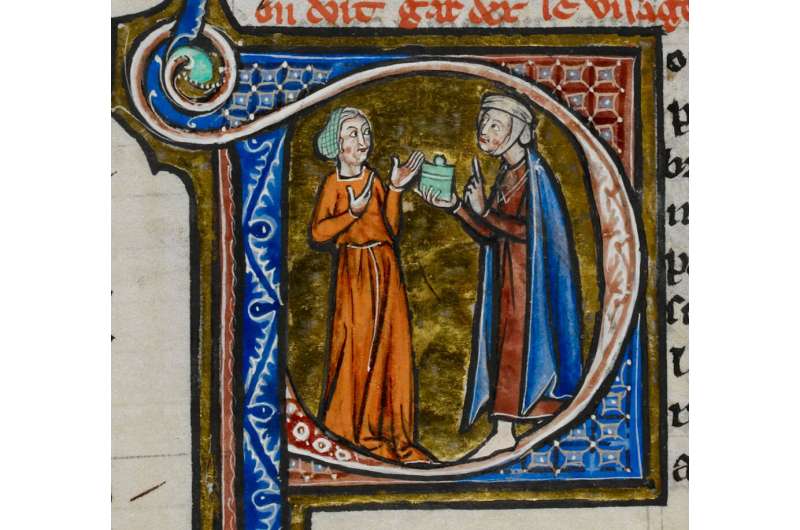'Le Régime du corps' described a variety of ways to maintain health by keeping the body in balance. The Bute Painter, circa 1285, MS Arsenal 2510. Credit: Bibliothèque nationale de France
What type of images come to mind when you think of medieval art? Knights and ladies? Biblical scenes? Cathedrals? It's probably not some unfortunate man in the throes of vomiting.
It might surprise you to learn this scene is found in a luxurious book from the Middle Ages made with the highest-quality materials, including abundant gold leaf. Known as an illustrated manuscript, it was made entirely by hand, as virtually all books were before the adoption of the printing press.
Why would such an opulent art form depict such a mundane topic?
Scholars believe that around 1256, a French countess commissioned the creation of a health manual to share with her four daughters just as they were forming their own households. Known as the "Régime du corps," or "regimen of the body," the book was widely copied and became extremely popular across Europe in the late Middle Ages, specifically between the 13th and 15th centuries. Over 70 unique manuscripts survive today. They offer a window into many aspects of everyday medieval life—from sleeping, bathing and preparing food to bloodletting, leeching and purging.
I'm an art historian who recently published a book called "Visualizing Household Health: Medieval Women, Art, and Knowledge in the Régime du corps" about these magnificent illustrated copies. What's fascinating to me about the "Régime du corps" is how it depicts the responsibilities of women in wealthy medieval households—and how domestic management advice was passed down among them.
It might surprise you to learn this scene is found in a luxurious book from the Middle Ages made with the highest-quality materials, including abundant gold leaf. Known as an illustrated manuscript, it was made entirely by hand, as virtually all books were before the adoption of the printing press.
Why would such an opulent art form depict such a mundane topic?
Scholars believe that around 1256, a French countess commissioned the creation of a health manual to share with her four daughters just as they were forming their own households. Known as the "Régime du corps," or "regimen of the body," the book was widely copied and became extremely popular across Europe in the late Middle Ages, specifically between the 13th and 15th centuries. Over 70 unique manuscripts survive today. They offer a window into many aspects of everyday medieval life—from sleeping, bathing and preparing food to bloodletting, leeching and purging.
I'm an art historian who recently published a book called "Visualizing Household Health: Medieval Women, Art, and Knowledge in the Régime du corps" about these magnificent illustrated copies. What's fascinating to me about the "Régime du corps" is how it depicts the responsibilities of women in wealthy medieval households—and how domestic management advice was passed down among them.

In a chapter on caring for one's complexion, two women exchange a remedy. 'Le Régime du corps,' circa 1265-70. British Library, MS Sloane 2435. Credit: The British Library Board
Glimpsing relationships
The illustrations, which are usually located at the start of each chapter, convey information not often found in other historical records. Even if the images are idealized, they reveal an extraordinary amount about the clothes, objects and furnishings of the period. They also show interactions among people that reflect the culture and society in which these books were made. READ MORE...
The illustrations, which are usually located at the start of each chapter, convey information not often found in other historical records. Even if the images are idealized, they reveal an extraordinary amount about the clothes, objects and furnishings of the period. They also show interactions among people that reflect the culture and society in which these books were made. READ MORE...
